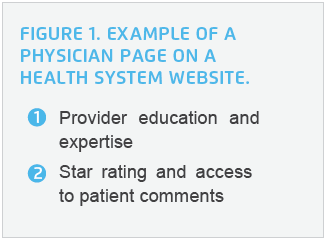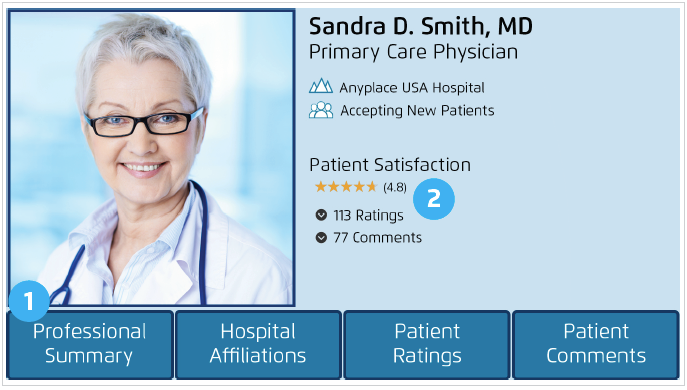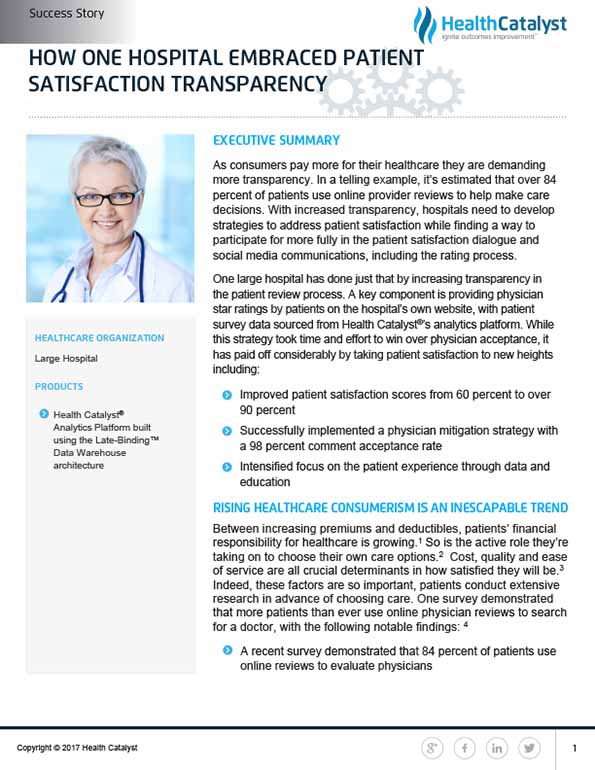As healthcare costs rise, patients seek transparency, with over 84 percent using online reviews for decisions. This hospital improved patient satisfaction by implementing physician star ratings on its website, leveraging data from its analytics platform. This initiative successfully engaged physicians and enhanced the overall quality and patient satisfaction.
As consumers pay more for their healthcare, they are demanding more transparency. In a telling example, it’s estimated that over 84 percent of patients use online provider reviews to help make care decisions. With increased transparency, hospitals need to develop strategies to address patient satisfaction while finding a way to participate for more fully in the patient satisfaction dialogue and social media communications, including the rating process.
One large hospital has done just that by increasing transparency in the patient review process. A key component is providing physician star ratings by patients on the hospital’s own website, with patient survey data sourced from Health Catalyst’s analytics platform. While this strategy took time and effort to win over physician acceptance, it has paid off considerably by taking patient satisfaction to new heights.
Between increasing premiums and deductibles, patients’ financial responsibility for healthcare is growing.1 So is the active role they’re taking on to choose their own care options.2 Cost, quality and ease of service are all crucial determinants in how satisfied they will be.3 Indeed, these factors are so important, patients conduct extensive research in advance of choosing care. One survey demonstrated that more patients than ever use online physician reviews to search for a doctor, with the following notable findings:4
Not surprisingly, higher patient satisfaction rates have been shown to be strongly related to greater patient loyalty and a greater likelihood to recommend a provider to family and friends.5 This story describes how one large hospital embraced the need for greater transparency in healthcare and increased patient satisfaction to impressive heights—over 90 percent—while overcoming physicians’ reservations about online reviews.
Fair or not, being a physician today means being subjected to very public review on the Internet. While this presents physicians and the hospitals that employ them with a chance to increase and publicize patient satisfaction, the current online ratings landscape comes with serious limitations. Reviews related to a provider’s care and services are typically scattered across many public social media sites and are rarely as robust and accurate as information already available to hospitals from national patient satisfaction surveys.
Ultimately, this particular hospital believed that data from existing and future patient satisfaction surveys—developed by the hospital and publicized on the hospital’s own website—presented an opportunity to more accurately and comprehensively inform the public about patient satisfaction with its care and services. To a significant degree, this would hinge on gaining physician appreciation of transparency as a means for improving communication and patient satisfaction.
To increase transparency of the patient review process—and ignite broad and sweeping improvements—the hospital used an effective blend of data and strategies.
One of the best indicators of an overall experience is a patient’s likelihood to recommend the health system to friends and family. As such, this hospital welcomed feedback from patients and families about their care experience. The hospital participated in patient experience surveys that are administered confidentially and anonymously through an independent third party. Patients typically are provided with a survey following a hospital stay or clinic visit. Survey results and comments are screened using the Health Catalyst analytics platform to remove objectionable comments and patient specific references and then stored in a physician transparency data mart where they are easily accessible. After a careful review process that, if needed, allows for a physician appeal, the results are posted on individual physician pages (see Figure 1). These results are closely monitored to help hospital leadership better understand how to further improve the care experience.
To motivate change and care alignment across the health system’s care entities, hospital leadership kicked off the initiative with a series of educational road shows aimed at overcoming initial resistance and engaging physicians in improving the patient experience. The hospital also learned that it is important to allow adequate time for such a meaningful culture change to happen. In fact, rushing acceptance would very likely only increase distrust and resistance. To that end, leadership also launched programs to improve physicians’ work experience so they could focus on improving patient satisfaction. This spanned from lightening clinic loads to changing staff assignments. Additionally, physicians were given general coaching on how to more effectively engage with patients and their family members.
In January of 2015, the hospital’s website began including physician web profiles that featured patient satisfaction star ratings and patient comments from the provider section of the satisfaction survey. Star ratings are based on a number of metrics—from how well the care provider communicated with the patient, to the duration of wait time in the clinic. Importantly, these metrics also include how likely the patient was to recommend the provider to others. Physicians with at least 30 survey responses for “Likelihood of recommending care provider” for a 24-month period will have star ratings and comments added to the physician profile page (see Figure 1).
To be as transparent as possible, the vast majority of comments are posted unedited. Exceptions are made only if a comment falls within a very narrow set of exclusion criteria. In an effort to incentivize engagement and progress, physician compensation is partially linked to their patient satisfaction scores.


A governance committee consisting of service line medical directors, the chief medical officer, and the chief of staff carefully review comments about clinical care. They only edit comments in obvious instances of profane or libelous language, potential Health Insurance Portability and Accountability Act privacy breaches, and the like. Additionally, physicians have the opportunity to review comments before they are posted publicly, and an appeal process is available to dispute comments going public. This process itself is conducted in a timely and organized fashion to assure a thorough and fair review before posting.
Initially, the appeals process was more black and white. In order to increase physician receptivity, the governance committee introduced a set of guiding principles to cite for approving appeals decisions, especially more difficult appeals. These consider the physician’s perspective and experience to the fullest extent possible.
Of course, examples of service excellence are also used to promote additional improvement.
The health system implemented a framework to help care team members learn best practice communication techniques and develop relationship-based care approaches with patients. The framework outlines key interactions and suggested prompts (“words that work”) that can help care team members during patient encounters. On the surface, these appear simple actions of courtesy; however, they significantly heighten patient trust and comfort levels.
Professional and confidential counseling is offered to individuals facing personal and/or professional challenges. One-on-one physician coaching is available to physicians on request or mandated in special situations.
The overall patient satisfaction improvement initiative, of which the physician transparency effort was a key component, has proven to be resoundingly successful in supporting physicians and staff in the difficult work of providing outstanding and compassionate care—and has reaped impressive results.
Improved satisfaction scores from 60 percent to over 90 percent. Scores based on independent survey data have shot up. The majority of patient feedback comments regarding physicians over approximately a three-year period were resoundingly positive (85 percent of over 11,000 comments). Providing even further evidence of an improved patient experience are the unsolicited comments from patients about the exceptional care they receive from the physicians and staff at the health system.
Successfully implemented physician mitigation strategy with a 98 percent comment acceptance rate. Of the more than 8,000 comments received in 2015—first reviewed by the governance committee following exclusion criteria and then by the individual physician—only 2 percent were appealed. Of those, the governance committee agreed with physicians 71 percent of the time and those comments were not posted online.
Expanded focus on the patient experience through the use of data and education. The health system successfully addressed the need for greater transparency in healthcare through the use of data and education to motivate change, create alignment across care entities, and realize an expanded focus on patient experience among physicians and staff. Patient-centered education increased, along with enriched communication between providers and providers and their patients.
“For each number in a dashboard, there’s a patient list behind that. With the analytics application, it’s about two clicks to access the patient information behind the numbers in a report. It’s all there in one place now, and it’s standardized across the system."
– Rex McWilliams, CIO, Mountain Area Health, Education Center (MAHEC)
The hospital intends to expand this successful program beyond its outpatient clinics to affiliated specialists. It’s even exploring expanding to inpatient care, although this will be a more complex undertaking as inpatients generally have multiple physicians. Further tweaking will be done on the website to create a more homogenous look and feel for the reviews that have already done so much to improve patient satisfaction.


